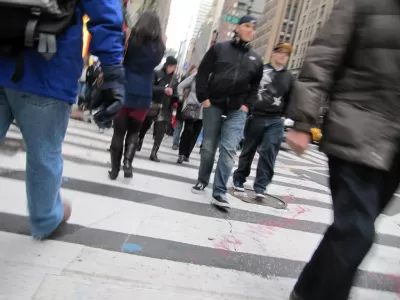Like a school of fish navigating the ocean depths or a mass migration of wildebeests, pedestrians follow fundamental laws of swarm behavior when making their way through crowded sidewalks. Alexandra Horowitz explains the laws of the herd.

If you've ever tried to navigate the sidewalks of SoHo on a busy weekend, it may seem like the maddening pedestrian behavior is chaotic and irrational. To the contrary, however, humans behave like other animals in crowds, according to a natural logic. And the science of pedestrian movement can help explain how the sidewalk animals are behaving. With the help of Fred Kent, from the Project for Public Spaces, who learned his craft from the eminent urban sociologist William H. Whyte, Horowitz describes the three primary rules that guide pedestrian movement.
"First, avoid bumping into others (while staying comfortably close)... A second rule: Follow whoever is in front of you... The final rule: Keep up with those next to you," explains Horowitz.
"These rules of 'attraction' (staying with others ...), 'avoidance' ( ...while not too close), and 'alignment' (going the same direction and speed as those around you) are sufficient to explain all herd, school, flock and swarm behavior — not to mention that of big-brained and busy human pedestrians."
FULL STORY: Walk Like a Fish

Maui's Vacation Rental Debate Turns Ugly
Verbal attacks, misinformation campaigns and fistfights plague a high-stakes debate to convert thousands of vacation rentals into long-term housing.

Planetizen Federal Action Tracker
A weekly monitor of how Trump’s orders and actions are impacting planners and planning in America.

In Urban Planning, AI Prompting Could be the New Design Thinking
Creativity has long been key to great urban design. What if we see AI as our new creative partner?

King County Supportive Housing Program Offers Hope for Unhoused Residents
The county is taking a ‘Housing First’ approach that prioritizes getting people into housing, then offering wraparound supportive services.

Researchers Use AI to Get Clearer Picture of US Housing
Analysts are using artificial intelligence to supercharge their research by allowing them to comb through data faster. Though these AI tools can be error prone, they save time and housing researchers are optimistic about the future.

Making Shared Micromobility More Inclusive
Cities and shared mobility system operators can do more to include people with disabilities in planning and operations, per a new report.
Urban Design for Planners 1: Software Tools
This six-course series explores essential urban design concepts using open source software and equips planners with the tools they need to participate fully in the urban design process.
Planning for Universal Design
Learn the tools for implementing Universal Design in planning regulations.
planning NEXT
Appalachian Highlands Housing Partners
Mpact (founded as Rail~Volution)
City of Camden Redevelopment Agency
City of Astoria
City of Portland
City of Laramie





























